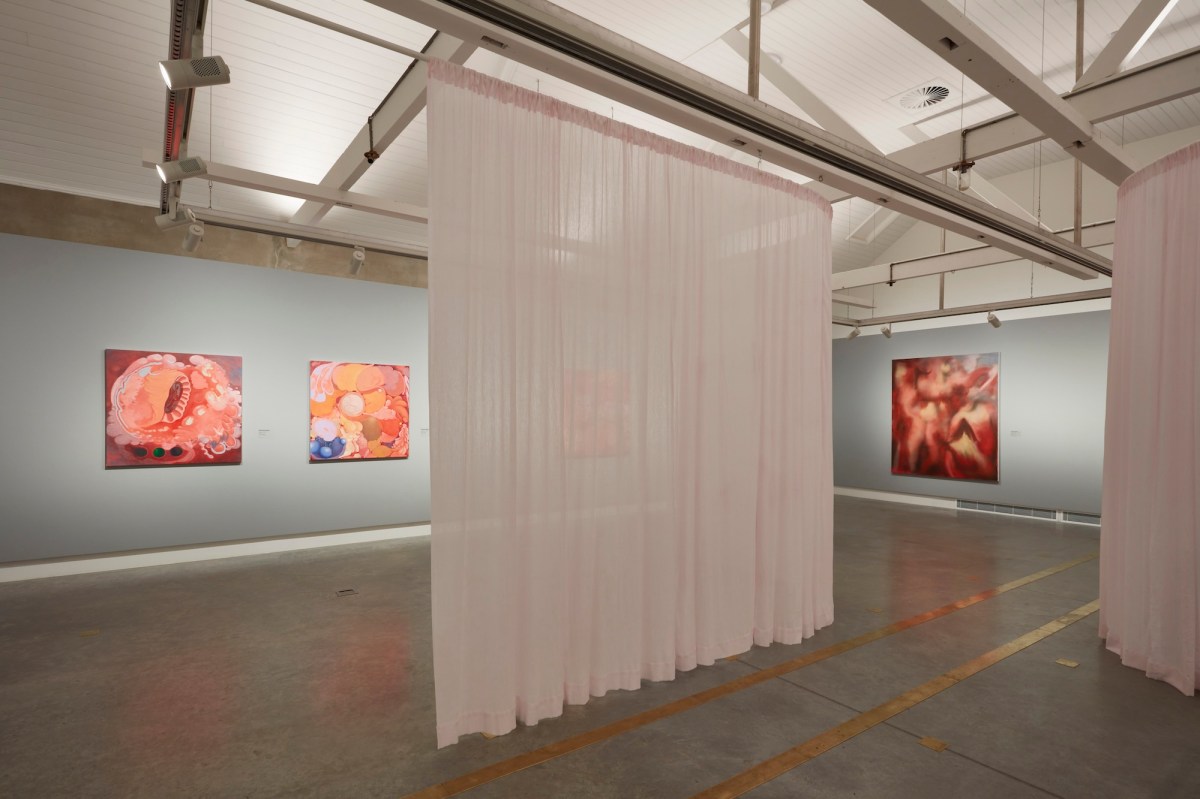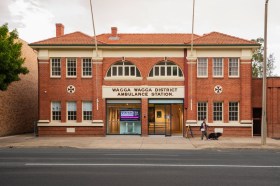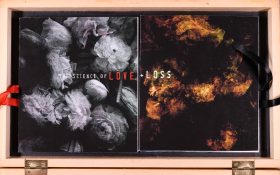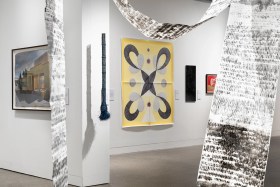Tender is Ngununggula’s third exhibition funded by its Artist’s Circle Patron Program, in a commitment to showcasing the work of living Australian women artists. It has been a move to ensure that women artists were represented in the regional gallery’s annual programming, and alternates year-on-year between a group exhibition and solo presentation.
For 2025, Tender brings together seven painters, who have an amazing synergy despite stylistic differences and career stages. They are: Sally Anderson, Sarah Drinan, Laura Jones, India Mark, Dionisia Salas, Julia Trybala and Amber Wallis.
While in the first gallery the viewer walks into a solo presentation by Trybala, the other galleries pair up the artists – first Drinan and Salas in the main gallery, followed by a more intimate hang of works by Anderson and Mark in the smaller internal gallery, and finishing with Wallis and Jones in the end gallery.
These pairings are incredibly sensitive and sympathetic, in terms of gesture and palette, and yet each artist embraces a highly individualistic style, making for a nuanced exhibition.
The theme Tender was a springboard for the artists to consider what associations we may bring to a gendered reading of care and femininity, over more unilateral observations of human emotion and tenderness within the natural world.
In terms of presentation, Ngununggula lives up to its reputation for shifting things up. Sight lines in the two larger galleries are obscured by soft pink scrims, which hang in gentle curves in the space, and they feel fleshy and curvaceous in their subtle reference. What is nice is that they both obscure and reveal the paintings in the room, creating long vistas with end notes and zones of intimacy for contemplation. It is a really smart device that also works conceptually, and is testament to a well-considered curatorial premise.
Visitors first see this in play with Drinan’s and Salas’ paintings. Drinan’s air-brushed pieces work especially well with the floating scrims. Her large canvases sit slightly beyond grasp, feeling bodily in moments, and then ethereal and transformative in another – alluding more to an emotional scale than a physical one. The viewer easily falls into their softness and, spending time with them, opens up to their complexities.
Salas, in contrast, works with more articulated forms that sit on the canvas in a kind of dreamscape. She doesn’t shy away from bold colours, but rather uses deep reds to evoke a bruise, blood, flesh and hair.
Moving deeper into the exhibition, a dance between scale is beautifully choreographed between India Mark’s petite, precise still lives, alongside the open, gestural studies by Sally Anderson. In an uncanny way, some elements within Anderson’s paintings can be read at the same scale as Mark’s objects – allowing the viewer’s eye to easily pull between the two.

Composition is key to both artists’ practice, and yet it is handled in very different ways. For Marks, the interest in the still life is one historically dominated by women. Just as Mark’s still lifes are a composed narrative of elements, Anderson similarly also plays with memory within a minimal composition, moving between landscape, bodily representation, still life elements such as talismans and an overarching abstraction. Both seemingly are light-filled, and celebrate the small things in the everyday.
For Anderson motherhood is central, and yet it is not burdened by a domestic environment. Indeed the worlds of inside and outside seem to move across a permeable divide where they co-exist and are each informed by the other.
In the end gallery, Jones’ oil paintings dwell in the domestic settling – scenes mapped as a kind of visual diary, such as a gathering around her childhood dining table or an intimate embrace. These are interspersed with floral studies, connecting the natural landscape with the domestic interior.
Working with oil, Jones layers the paint thinly, building up to create their depth and intense palette. They sit in contrast with Wallis’ paintings – which are also created in layers – but as thin veils of information, such as a gentle line over a gessoed surface.
Read: Exhibition review: Wedgwood: Artists and Industry, Perc Tucker Regional Gallery
Completing the show is where it starts – the first gallery with Trybala’s work. While the two larger galleries have a similar energy, this suite of paintings feels like a ode to another time, where art history seeps into the layers of paint, and yet a highly individualised painterly language carves out the politics of the feminine body in space and the complexity of human relationships.
It is funny how this exhibition feels feminine, without being labelled as such. It is bold, confident painting that is not afraid to lay emotions bare. And from a curatorial perspective, it gives space to those personal narratives, while making sense of them in a viewing experience.
Tender will be exhibited at Ngununggula, the Southern Highlands Regional Art Gallery 1 Art Gallery Road, Bowral, Southern Highlands (NSW) until 15 June; free.





